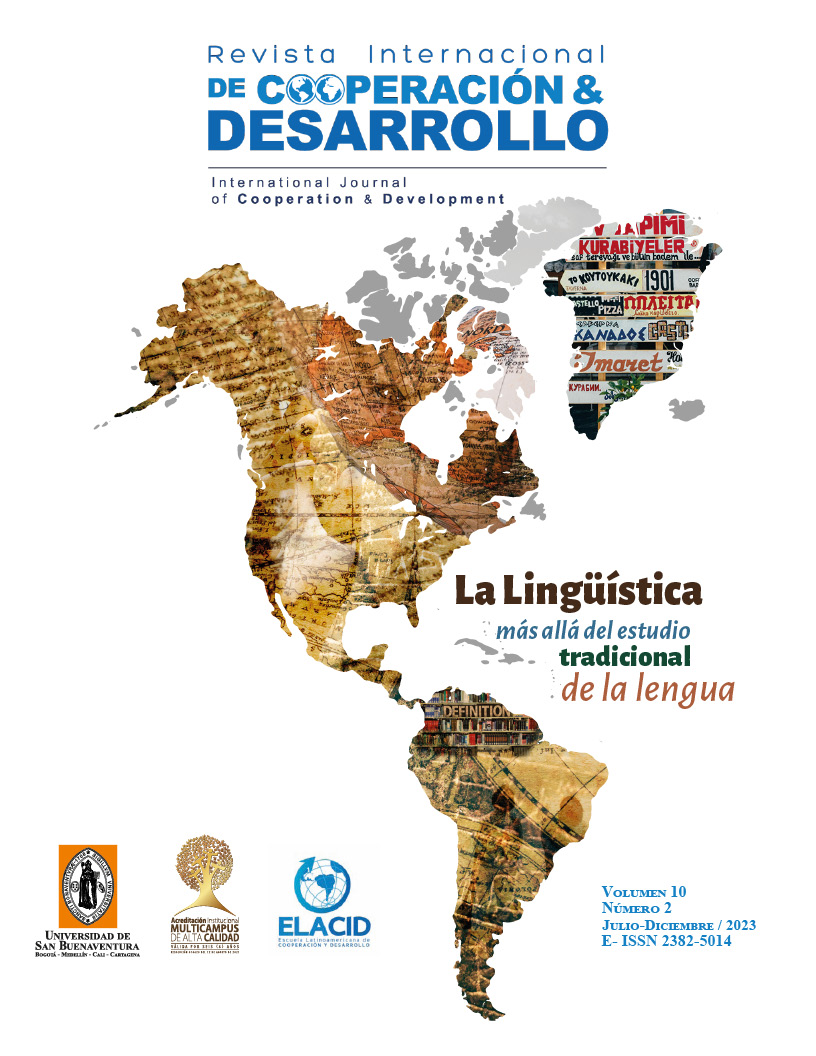INTERNATIONAL JOURNAL OF COOPERATION AND DEVELOPMENT
Assignment of Rights
Authorization for reproduction, publication, communication and distribution of a literary, artistic or scientific
Work.
I , ____________________________________________, author of the book and / or article , of legal age , resident of the city of _________________ , identified with citizenship / passport n° ______________________ issued on _______________________, in exercise of his physical and mental faculties , part henceforth be called the AUTHOR , supports the following authorization to the reproduction, publication, communication and distribution of a work, perform the following terms:
1. Regardless of current legal regulations due to the linking of the parties to this contract, and any kind of legal presumption , the parties agree that the AUTHOR authorize ( name of the publisher ) to reproduce , publish , communicate and distribute the material referred to in the International Journal of Cooperation and Development of the University of San Buenaventura.
2. Such authorization lies in particular on the copyright of the work, by any means known or unknown, publication of the work, distribution of the work , either directly or through third parties for purely educational purposes.
3. AUTHOR agrees to report and declare the existence of this authorization and to preserve the right of the International Journal of Cooperation and Development of the first publication of the work.
4. AUTHOR declares that the article is original and that it is his sole creation, no impediment of any kind exist for the authorization he is doing, besides being responsible for any action claim, plagiarism or other type of claim that might arise about .
5. Such permission is free of charge.
6. Moral copyright in the article are solely the AUTHOR and the University of San Buenaventura expressly agrees to recognize and respect them rigorously.
The Author and / or AUTHORS
SIGNATURE
Abstract
The article presents a contextualization of the forms of address of the second person singular pronoun in the three main cities of Colombia, Bogotá, Medellín and Cali. Based on studies on pronouns carried out in cities through the creation of corpus, the current situation of these treatments is presented. We found that there appears to be an ongoing shift towards more supportive uses in all three cities, solidarity, and we question whether the improvement in economic poverty indicators in these cities could be one of the factors influencing this shift.
References
Avendaño, G. (2014). Formas pronominales de tratamiento y cortesía en el habla de Tunja, Colombia. Folios, 39, 31–49. https://doi.org/10.17227/01234870.39folios31.49
Bartens, A. (2003). Notas sobre el uso de las formas de tratamiento en el español colombiano actual. Pronombres de segunda persona y formas de tratamiento en las lenguas de Europa, 20. https://cvc.cervantes.es/lengua/coloquio_paris/ponencias/pdf/cvc_bartens.pdf
Bayona, P. (2006). Sociolinguistic competence in the use of Colombian pronouns of address. En P. Gurski & M. Radisic (Eds.), Actas del congreso de la asociación canadiense de lingüística. https://www.researchgate.net/publication/241065313
Bishop, K., & Michnowicz, J. (2010). Forms of Address in Chilean Spanish. Hispania, 93(3), 413–429.
Brown, P., & Levinson, S. (1987). Politeness. Some universals in language use. Cambridge University Press.
Brown, R., & Gilman, A. (1960). The Pronouns of Power and Solidarity. En T. Sebeok, Style in Language (pp. 252–281). The M.I.T. Press.
Calderón, M., & Medina, F. (2010). Historia y situación actual de los pronombres de tratamiento en el español peninsular. En M. Hummel, B. Kluge, & M. E. Vázquez (Eds.), Formas y fórmulas de tratamiento en el mundo hispánico (1. ed, pp. 195–222). El Colégio de México.
Cepeda, C. Y. (2014). Usted, tú, sumercé y vos, formas pronominales de tratamiento en el español de Bogotá [Maestría, Universidad Nacional Autónoma de México]. http://132.248.9.195/ptd2014/octubre/0721377/Index.html
Cisneros, M. (1996). Aspectos histórico-pragmáticos del voseo. Thesaurus, LI(1), 27–43.
DANE. (2018). Censo Nacional de Población y Vivienda 2018. https://www.dane.gov.co/index.php/estadisticas-por-tema/demografia-y-poblacion/censo-nacional-de-poblacion-y-vivenda-2018
Denbaum- Restrepo, N. (2021). Polymorphism of second person singular forms of address in Medellín, Colombia: Usage and language attitudes. [Doctoral, Indiana University]. http://rgdoi.net/10.13140/RG.2.2.30947.27680
Denbaum-Restrepo, N., & Restrepo-Ramos, F. (2022). Formas de tratamiento de segunda persona singular en el español de Medellín, Colombia: Producción y actitudes lingüísticas. Sociocultural Pragmatics, 10(1), 1–25. https://doi.org/10.17710/soprag.2022.10.1.denbaumrestrepo2
Dos Santos, I. (2019). Los usos de la forma de tratamiento de segunda persona singular “vos” entre los estudiantes en la Universidad de Nariño – Colombia [Pregrado, Universidad Federal de Sao Carlos]. https://repositorio.ufscar.br/bitstream/handle/ufscar/12920/TCC_%20Izabel%20dos%20Santos%20Caliri%20(1).pdf?sequence=1
Fernández-Mallat, V. (2020). Forms of address in interaction: Evidence from Chilean Spanish. Journal of Pragmatics, 161, 95–106. https://doi.org/10.1016/j.pragma.2020.03.006
Fernández-Mallat, V., & Barrero, D. (2023). Changes and continuities in second person address pronoun usage in Bogotá Spanish. Open Linguistics, 9(1), 20220241. https://doi.org/10.1515/opli-2022-0241
Flórez, L. (1953). Vos y la segunda persona verbal en Antioquia. Thesaurus, IX(1, 2 y 3), 7.
Flórez, L. (1963). El español hablado en Colombia y su Atlas lingüístico. Thesaurus, XVIII(2), 268–356.
Fontanella, M. B. (1999). Sistemas pronominales de tratamiento usados en el mundo hispánico. En V. Demonte & I. Bosque, Gramática descriptiva de la lengua española (Vol. 1, pp. 1399–1426). El Colegio de México. https://www.academia.edu/4030956/Sistemas_pronominales_de_tratamiento_usados_en_el_mundo_hispanico_MBFontanella
Freites, F. (2009). El tuteo entre los jóvenes tachirenses. Letras, 51(80), 321–348.
Frías Conde, X. (2018). Etiquetado y formas de tratamiento. Ianua editora.
Frías Conde, X. (2022). Las formas de tratamiento en el español de Bogotá: Una encrucijada. En N. Fabián & R. Vásquez (Eds.), Perspectivas actuales de la investigación en lingüística: Entre tradición y modernidad (pp. 39–52). Instituto Caro y Cuervo.
García, A. (2014). Las fórmulas del tratamiento en el español colombiano. Lingüística variacional: el uso de la lengua española en el mundo, Universität Viadrina Frankfurt Oder. https://www.academia.edu/7394896/_Las_f%C3%B3rmulas_de_tratamiento_en_el_espa%C3%B1ol_de_Colombia_
García Tesoro, A. I., & Jang, J. S. (2022). Consideraciones acerca de la noción de ‘usted’ de solidaridad en el español hablado en Medellín. Revista signos, 55(108), 212–234. https://doi.org/10.4067/S0718-09342022000100212
Goffman, E. (1970). Ritual de la interacción. Tiempo Contemporáneo.
Grajales Alzate, R., & Marmolejo Caicedo, M. (2021). Formas de tratamiento pronominales en el español de Cali, Colombia. Cuadernos de Lingüística Hispánica, 37, 1–15. https://doi.org/10.19053/0121053X.n37.2021.12694
Guarin, D. (2022). El uso de pronombres de tratamiento en el departamento del Quindío (Colombia). Miradas, 17(2), 65–82. https://doi.org/10.22517/25393812.25158
Jang, J. S. (2010). Fórmulas de tratamiento pronominales en los jóvenes universitarios de Medellín (Colombia) desde la óptica sociopragmática: Estrato socioeconómico y sexo. Íkala, Revista de Lenguaje y Cultura, 15(26), 43–116.
Jang, J. S. (2012). Cambio pronominal momentáneo en las relaciones interpersonales solidarias en los jóvenes universitarios de Medellín (Colombia). En G. Henry Vega & J. Escamilla Morales (Eds.), Miradas multidisciplinares a los fenómenos de cortesía y descortesía en el mundo hispánico (pp. 178–212). Universidad del Atlántico.
Jang, J. S. (2015). La frecuencia del tuteo en tres zonas del departamento de Antioquia (Colombia): Influencia de la zona urbana/rural. Forma y Función, 28(1), 11–29. https://doi.org/10.15446/fyf.v28n1.51969
Labov, W. (1966). The Social Stratification of English in New York City. Center for Applied Linguistics.
Labov, W. (1972). Sociolinguistics Patterns (Trad. esp.: Modelos sociolingüísticos, Madrid: Cátedra, 1983). Pennsylvania University Press.
Lapesa, R. (1970). Las formas verbales de segunda persona y los orígenes del voseo. En Actas del tercer congreso internacional de hispanistas (Digital, pp. 519–531). El Colegio de México. http://www.cervantesvirtual.com/obra/las-formas-verbales-de-segunda-persona-y-los-origenes-del-voseo/
Michnowicz, J., Despain, S., & Gorham, R. (2016). The changing system of Costa Rican pronouns of address: Tuteo, voseo, and ustedeo. En S. Rivera-Mills & M. Moyna (Eds.), Forms of address in the Spanish of the Americas (pp. 237–262). John Benjamins.
Michnowicz, J., & Quintana Sarria, V. (2020). A New Look at Forms of Address in the Spanish of Cali, Colombia. Bulletin of Hispanic Studies, 4, 20.
Miranda, J. A. (2013). El tratamiento pronominal Tú (Vos)/ Usted en español: El poder y la solidaridad. Contextos Lingüísticos, 7(8), 51–70.
Montes, J. J. (1967). Sobre el voseo en Colombia. Thesaurus, XXI(1), 21–44.
Montes, J. J. (1982). El español de Colombia: Propuesta de clasificación dialectal. Thesaurus, XXXVII(1), 23–92.
Moreno Fernández, F. (2021). Metodología del “Proyecto para el estudio sociolingüístico del español de España y de América” (PRESEEA). Editorial Universidad de Alcalá. https://doi.org/10.37536/PRESEEA.2021.doc1
Moreno-Fernández, F. (1986). Sociolingüística de los tratamientos. Estudios sobre una comunidad rural. Anuario de Letras: Lingüística y Filología, 24, 87–120.
Murillo, M. E. (2003). El polimorfismo en los pronombres de tratamiento del habla payanesa. 1–13. https://cvc.cervantes.es/lengua/coloquio_paris/ponencias/pdf/cvc_murillo.pdf
Myers, G. (1997). A Diachronic History of Spanish Second Person Pronoun Vos. Deseret Language and Linguistic Society Symposium, 23(1), 87–90.
Newall, G. (2012). Second person singular address forms in Caleño Spanish: Applying a theory of language regard [Doctoral, Indiana University Bloomington]. https://search.proquest.com/openview/e042a57d5b4416a2b5a0d4bb804d00df/1?pq-origsite=gscholar&cbl=18750&diss=y
Orozco, N. E. (2015). Formas de tratamiento: El uso de los pronombres tú y usted en una red social de docentes universitarios de Cartagena de Indias. [Maestría, Universidad Nacional de Colombia]. http://bdigital.unal.edu.co/48920/1/45531903.2015.pdf
Pla Cárceles, J. (1923). La evolución del tratamiento “vuestra-merced”. Revista de filología española, 245–280.
R.A.E. (2010). Manual de la nueva gramática de la lengua española. Espasa.
Rivadeneira, M. (2009). El voseo en medios de comunicación de Chile. Descripción y análisis de la variación dialectal y funcional. [Doctoral, Universitat Pompeu Fabra]. http://hdl.handle.net/10803/7510
Rojas, J. D. (2018). Formas y fórmulas de tratamiento en el español hablado en Sogamoso (Colombia) [Maestría, Universidad Pedagógica y Tecnológica de Colombia]. http://repositorio.uptc.edu.co/handle/001/2343
Sampedro, M. (2016). Las formas de tratamiento tú y usted en el español centro-norte peninsular. Estudios Sociolingüístico [Doctoral, Universidad de Salamanca]. https://gredos.usal.es/jspui/bitstream/10366/133055/1/REDUCIDA_Formastratamiento.pdf
Solé, Y. R. (1970). Correlaciones socio-culturales del uso de «tú» / «vos» y «usted» en la Argentina, Perú y Puerto Rico. Thesaurus, XXV(2), 161–195.
Uber, D. R. (1985). The Dual Function of usted: Forms of Address in Bogota, Colombia. Hispania, 68(2), 388. https://doi.org/10.2307/342216
Vargas Faulbaum, L. H., & Ibarra. (2015). Protección social y lucha contra la pobreza en Brasil, Colombia y Chile ¿graduarse de los PTC o salir de la pobreza? Revista Internacional de Cooperación y Desarrollo, 2(2), 267–273.
Vega, H. F. V. (2018). Cortesía verbal y fórmulas de tratamiento pronominales usadas en la cotidianidad por estudiantes de la universidad pedagógica y tecnológica de Colombia seccional Duitama [Maestría, Universidad Pedagógica y Tecnológica de Colombia]. http://repositorio.uptc.edu.co/handle/001/2342
Zwisler, J. J. (2017). Tú, Usted and the construction of male heterosexuality in young, working class men in Tolima. Cuadernos de Lingüística Hispánica, 29, 39. https://doi.org/10.19053/0121053X.n29.2017.5846
















